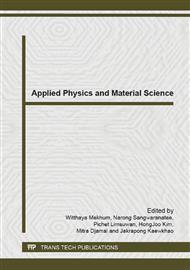[1]
M.E. Medhat, Gamma-ray attenuation coefficients of some building materials available in Egypt, Ann. Nucl. Energy. 36 (2009) 849–852.
DOI: 10.1016/j.anucene.2009.02.006
Google Scholar
[2]
I. Akkurt, S. Kilincarslan, C. Basyigit, The photon attenuation coefficients of barite, marble and limra. Ann. Nucl. Energy. 31 (2004) 577–582.
DOI: 10.1016/j.anucene.2003.07.002
Google Scholar
[3]
M.I. Awadallah, M.M. Imran, Experimental investigation of c-ray attenuation in Jordanian building materials using HPGe-spectrometer. J. Environ. Radioactivity. 94 (2007) 129–136.
DOI: 10.1016/j.jenvrad.2006.12.015
Google Scholar
[4]
I.C.P. Salinas, C.C. Conti, R.T. Lopes, Effective density and mass attenuation coefficient for building material in Brazil. Appl. Radiat. Isot. 64 (2006) 13–18.
DOI: 10.1016/j.apradiso.2005.07.003
Google Scholar
[5]
C. Singh, T. Singh, A. Kumar, G.S. Mudahar, Energy and chemical composition dependence of mass attenuation coefficients of building materials. Ann. Nucl. Energy. 31 (2004) 1199–1205.
DOI: 10.1016/j.anucene.2004.02.002
Google Scholar
[6]
I. Türkmen, Y. Özdemir, M. Kurudirek, F. Demir, Ö. Simsek, R. Demirboğa, Calculation of radiation attenuation coefficients in Portland cements mixed with silica fume, blast furnace slag and natural zeolite. Ann. Nucl. Energy. 35 (2008).
DOI: 10.1016/j.anucene.2008.03.012
Google Scholar
[7]
J.H. Hubbell, S.M. Seltzer, 1995. Tables of X-ray mass attenuation coefficients and mass energy absorption coefficients 1 keV to 20MeV for elements Z = 1–92 and 48 additional substances of dosimetric interest, NISTIR 5632.
DOI: 10.6028/nist.ir.5632
Google Scholar
[8]
Berger, M.J., Hubbell, J.H., 1987/1999. XCOM: photon cross sections database, Web Version 1. 2, available at http: / physics. nist. gov/xcom. National Institute of Standards and Technology, Gaithersburg, MD 20899, USA. (Originally published as NBSIR 87-3597 'XCOM: Photon Cross Sections on a Personal Computer', ).
DOI: 10.2172/6016002
Google Scholar
[9]
L. Gerward, N. Guilbert, K.B. Jensen, H. Levring, X-ray absorption in matter. Reengineering XCOM. Radiat. Phys. Chem. 60 (2001) 23–24.
DOI: 10.1016/s0969-806x(00)00324-8
Google Scholar
[10]
L. Gerward, N. Guilbert, K.B. Jensen, H. Levring, WinXCom–a program for calculating X-ray attenuation coefficients. Radiat. Phys. Chem. 71 (2004) 653–654.
DOI: 10.1016/j.radphyschem.2004.04.040
Google Scholar
[11]
I.I. Bashter, Calculation of radiation attenuation coefficients for shielding concretes. Ann. Nucl. Energy. 24 (1997) 1389–1401.
DOI: 10.1016/s0306-4549(97)00003-0
Google Scholar
[12]
D.F. Jackson, D.J. Hawkes, X-ray attenuation coefficients of elements and mixtures, Phys. Rep. 70 (1981) 169–233.
DOI: 10.1016/0370-1573(81)90014-4
Google Scholar


